Charles E W Bean, Diaries, AWM38 3DRL 606/264/1 - 1914 - 1938 - Part 17
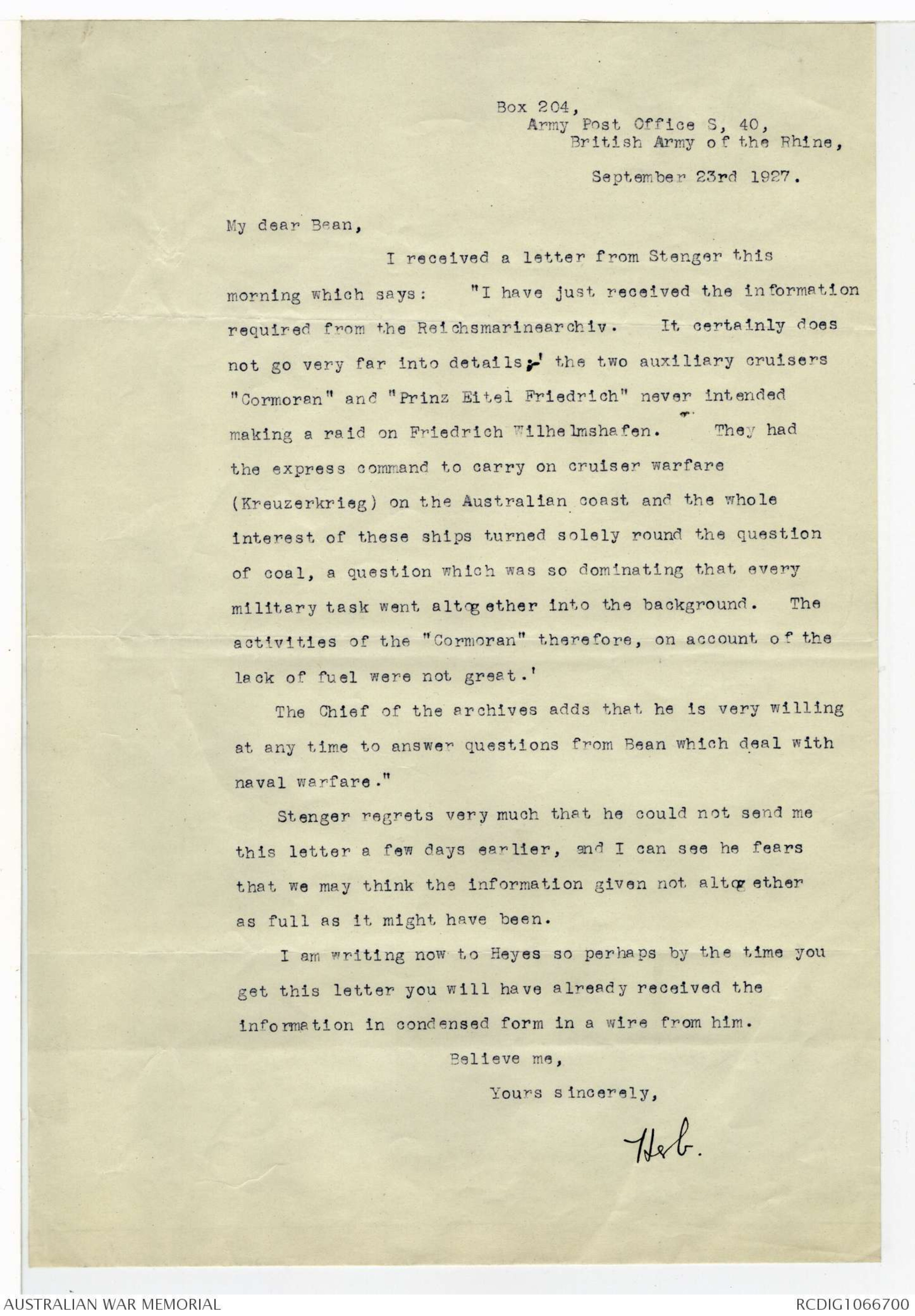
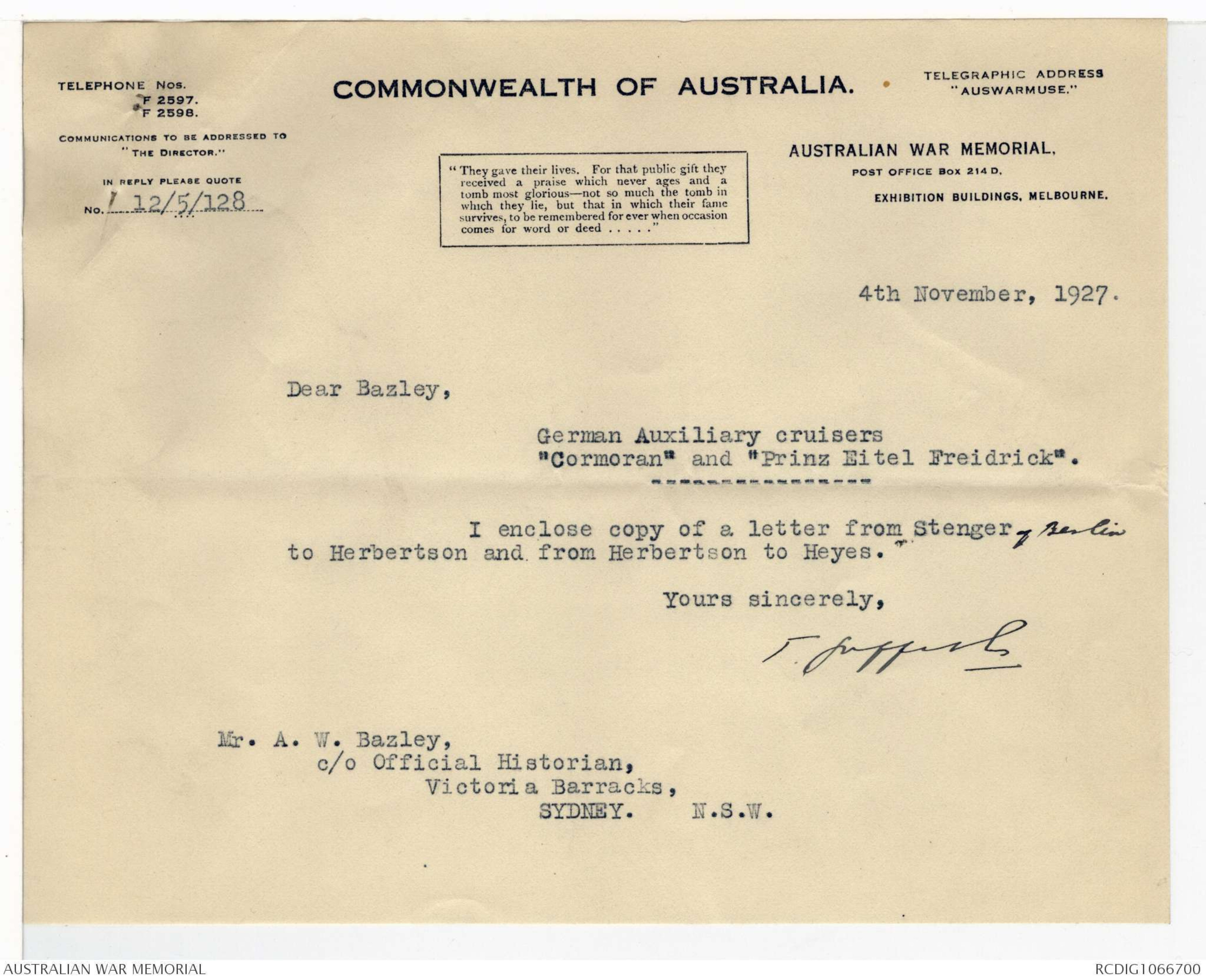
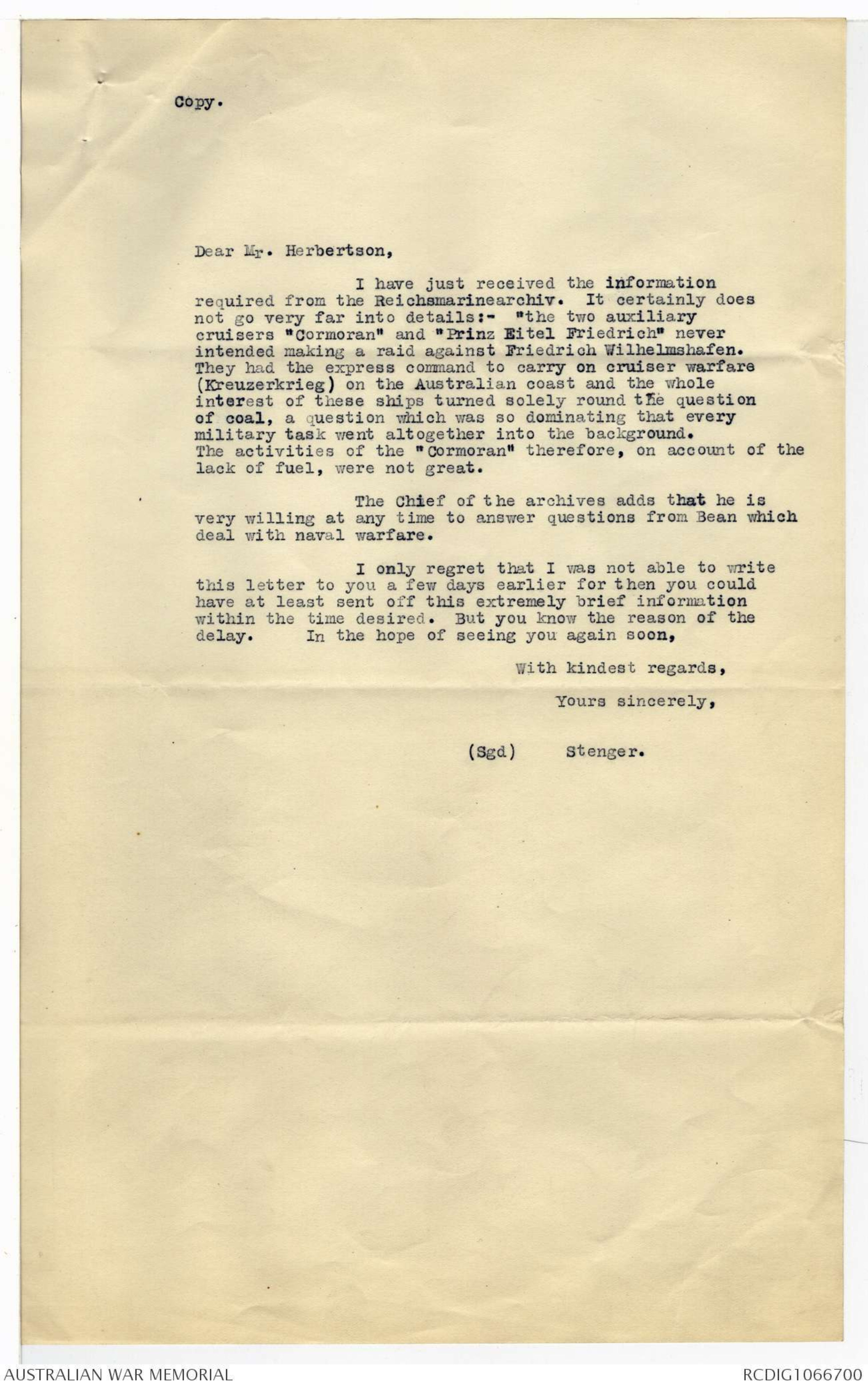
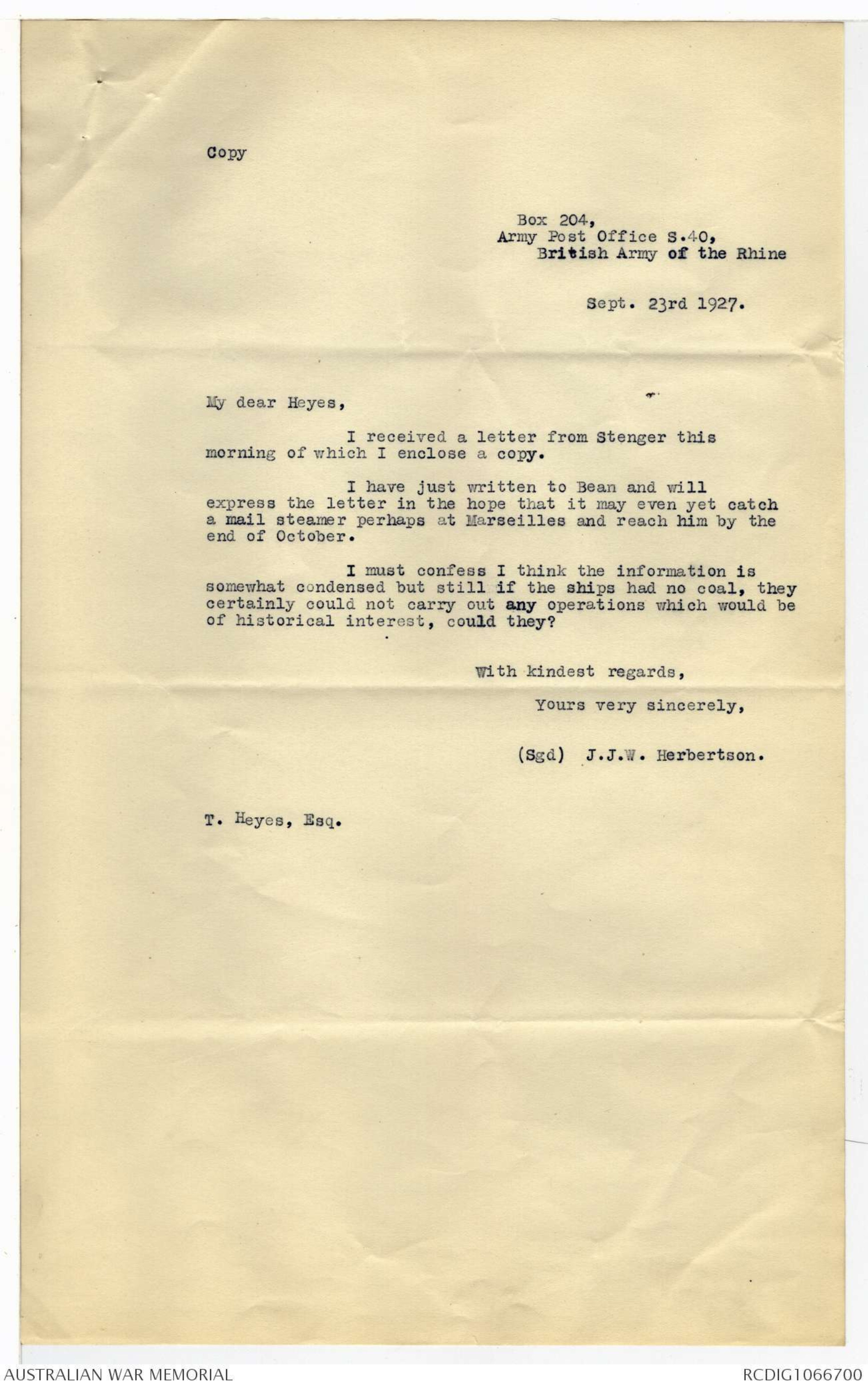
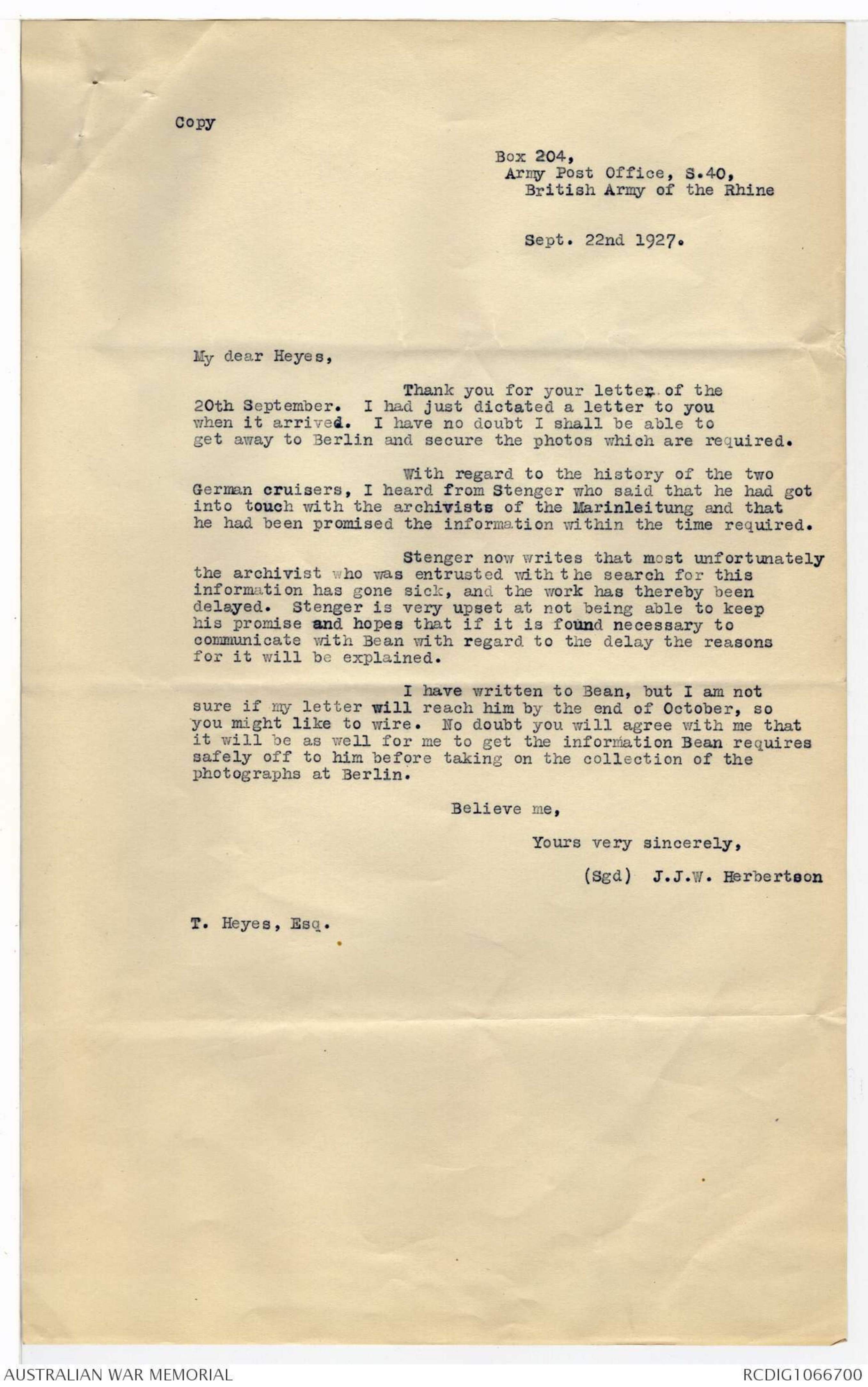


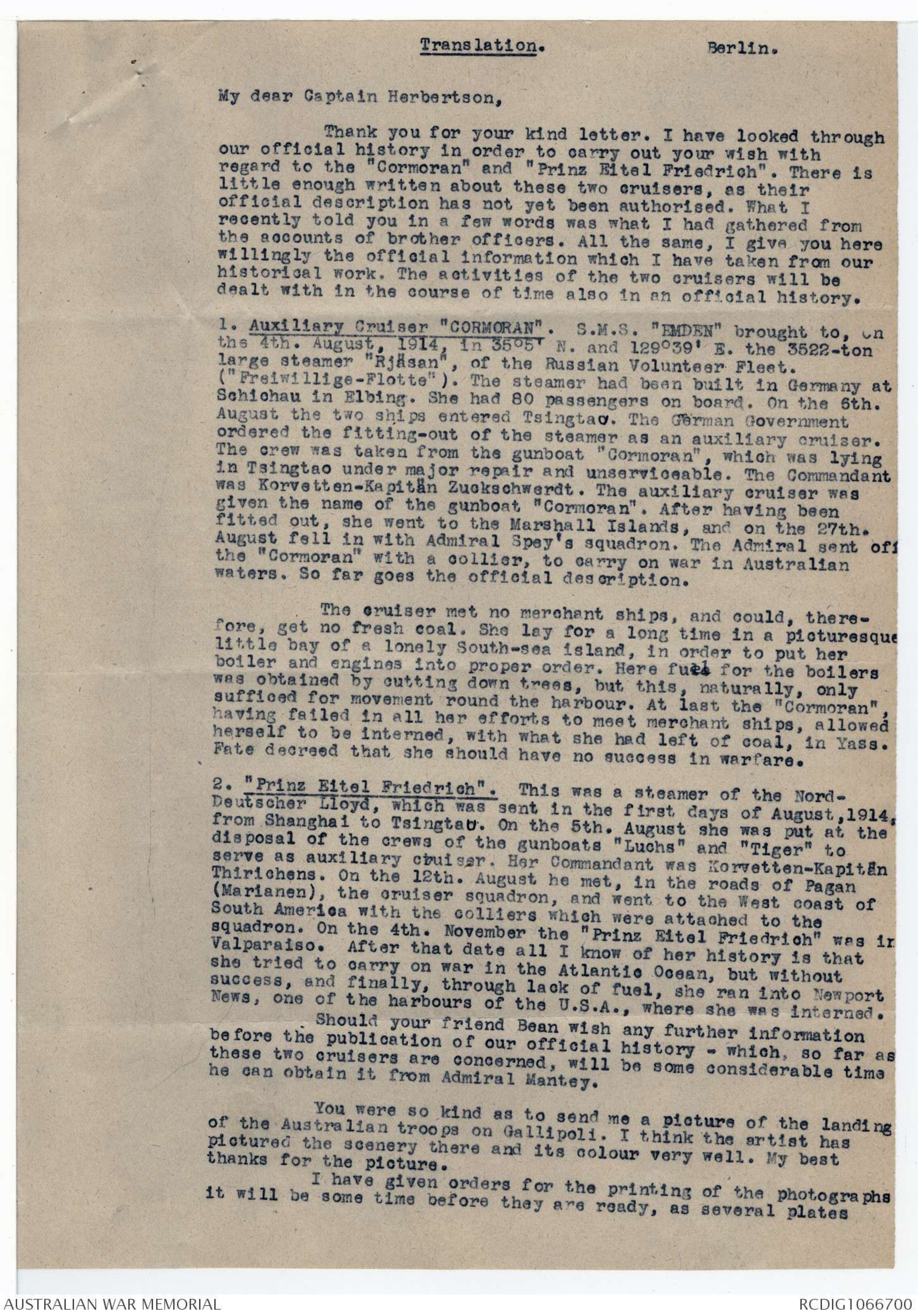
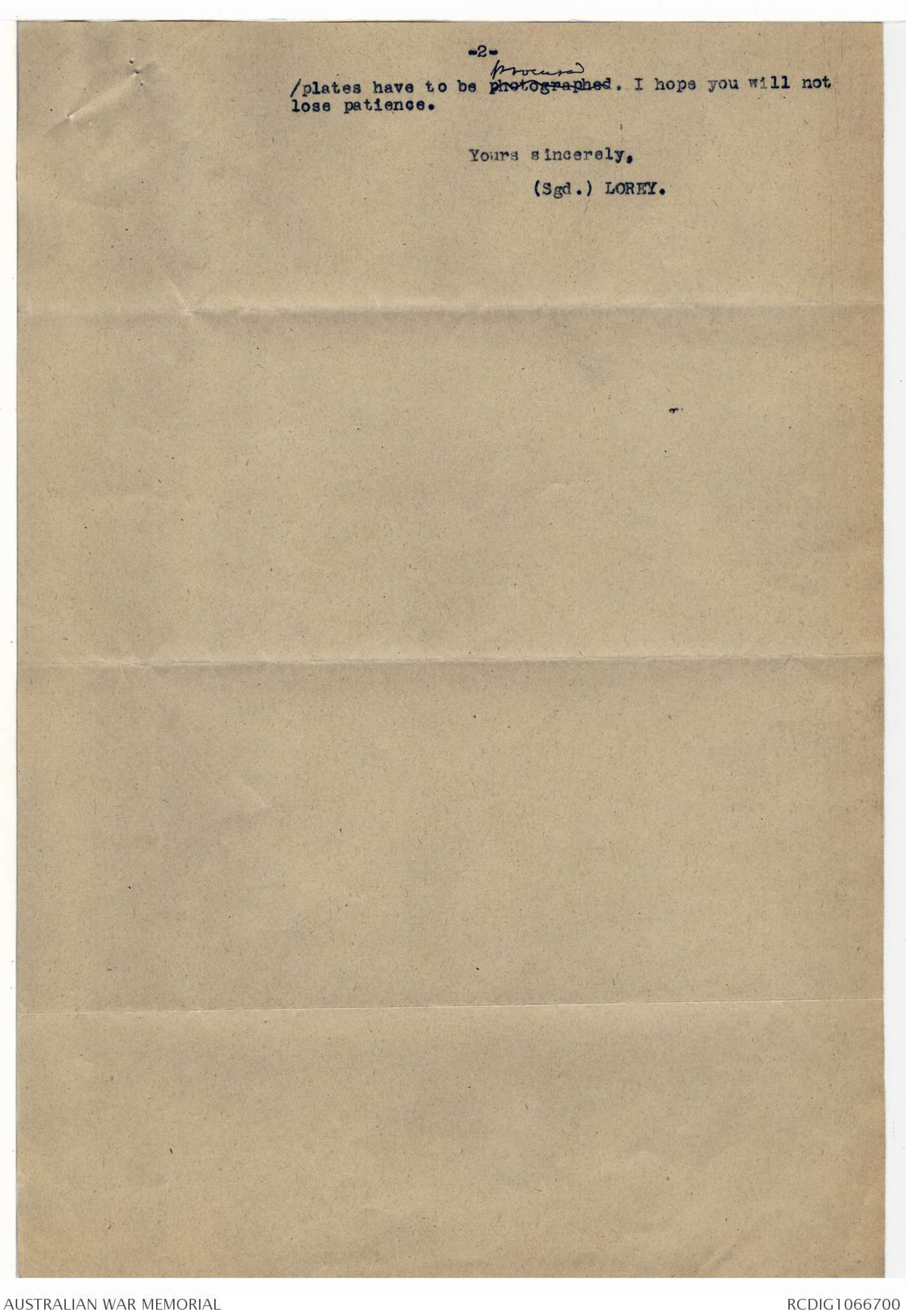
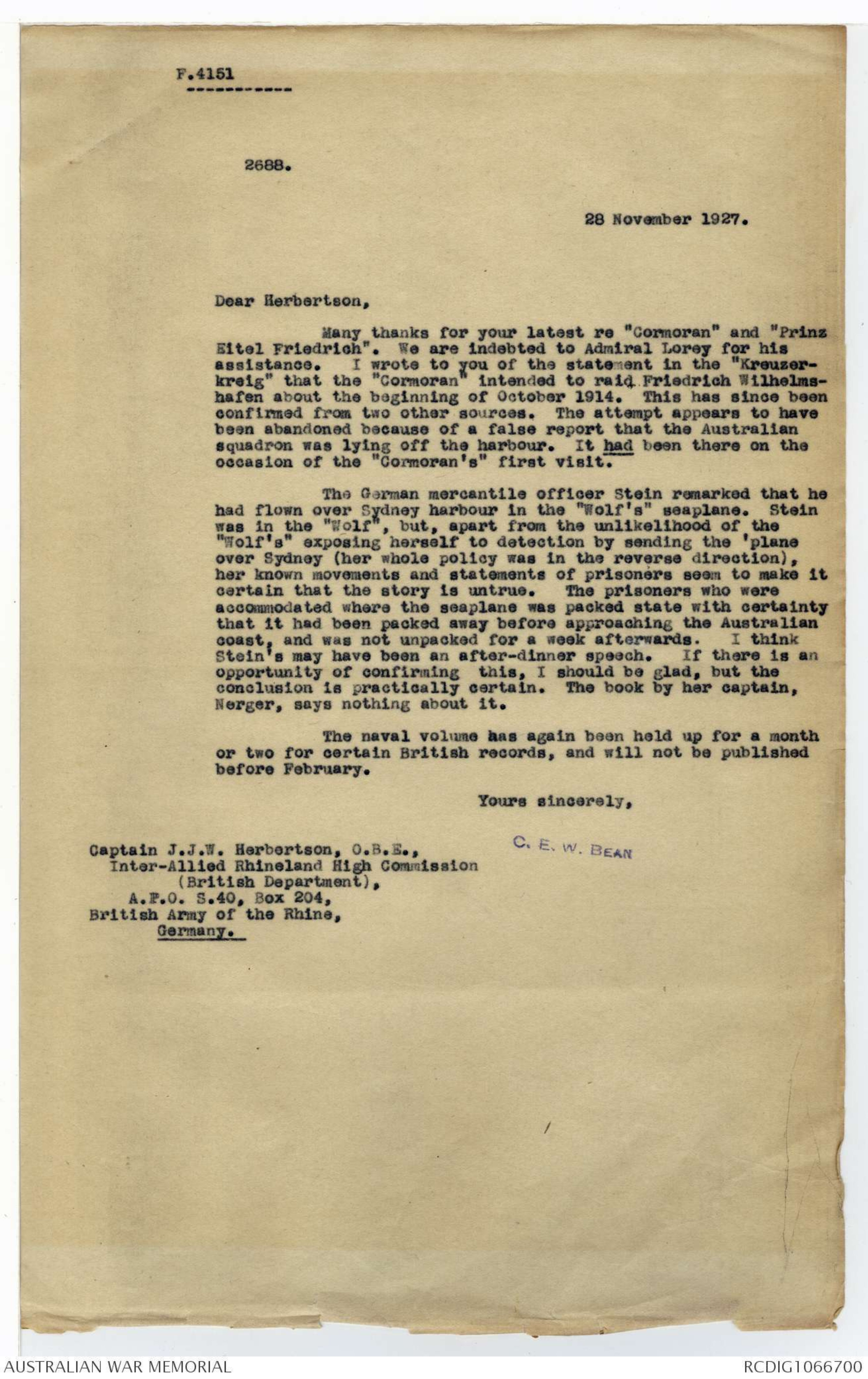
Box 204,
Army Post Office S, 40,
British Army of the Rhine,
September 23rd 1927.
My dear Bean,
I received a letter from Stenger this
morning which says: "I have just received the information
required from the Reichsmarinearchiv. It certainly does
not go very far into details:-' the two auxiliary cruisers
"Cormoran" and "Prinz Eitel Friedrich" never intended
making a raid on Friedrich Wilhelmshafen. They had
the express command to carry on cruiser warfare
(Kreuzerkrieg) on the Australian coast and the whole
interest of these ships turned solely round the question
of coal, a question which was so dominating that every
military task went altogether into the background. The
activities of the "Cormoran" therefore, on account of the
lack of fuel were not great.'
The Chief of the archives adds that he is very willing
at any time to answer questions from Bean which deal with
naval warfare."
Stenger regrets very much that he could not send me
this letter a few days earlier, and I can see he fears
that we may think the information given not altogether
as full as it might have been.
I am writing now to Heyes so perhaps by the time you
get this letter you will have already received the
information in condensed form in a wire from him.
Believe me,
Yours sincerely,
Heb.
TELEPHONE NOS.
F 2597.
F 2598.
COMMUNICATIONS TO BE ADDRESSED TO
"THE DIRECTOR."
IN REPLY PLEASE QUOTE
NO. 12/5/128
TELEGRAPHIC ADDRESS
"AUSWARMUSE."
COMMONWEALTH OF AUSTRALIA.
AUSTRALIAN WAR MEMORIAL,
POST OFFICE BOX 214 D.
EXHIBITION BUILDINGS, MELBOURNE.
"They gave their lives. For that public gift they
received a praise which never ages and a
tomb most glorious—not so much the tomb in
which they lie, but that in which their fame
survives, to be remembered for ever when occasion
comes for word or deed . . . . ."
4th November, 1927.
Dear Bazley,
German Auxiliary cruisers
"Cormoran" and "Prinz Eitel Freidrick".
I enclose a copy of a letter from Stenger of Berlin
to Herbertson and from Herbertson to Heyes.
Yours sincerely,
[[T sig?]]
Mr. A.W. Bazley,
c/o Official Historian,
Victoria Barracks,
SYDNEY. N.S.W.
Copy.
Dear Mr. Herbertson,
I have just received the information
required from the Reichsmarinearchiv. It certainly does
not go very far into details:- "the two auxiliary
cruisers "Cormoran" and "Prinz Eitel Friedrich" never
intended making a raid against Friedrich Wilhelmshafen.
They had the express command to carry on cruiser warfare
(Kreuzerkrieg) on the Australian coast and the whole
interest of these ships turned solely round the question
of coal, a question which was so dominating that every
military task went altogether into the background.
The activities of the "Cormoran" therefore, on account of the
lack of fuel, were not great.
The Chief of the archives adds that he is
very willing at any time to answer questions from Bean which
deal with naval warfare.
I only regret that I was not able to write
this letter to you a few days earlier for then you could
have at least sent off this extremely brief information
within the time desired. But you know the reason of the
delay. In the hope of seeing you again soon,
With kindest regards,
Yours sincerely,
(Sgd) Stenger.
Copy
Box 204,
Army Post Office S.40,
British Army of the Rhine
Sept. 23rd 1927.
My dear Heyes,
I received a letter from Stenger this
morning of which I enclose a copy.
I have just written to Bean and will
express the letter in the hope that it may even yet catch
a mail steamer perhaps at Marseilles and reach him by the
end of October.
I must confess I think the information is
somewhat condensed but still if the ships had no coal, they
certainly could not carry out any operations which would be
of historical interest, could they?
With kindest regards,
Yours very sincerely,
(Sgd) J.J.W. Herbertson.
T. Heyes, Esq.
Copy
Box 204,
Army Post Office, S.40,
British Army of the Rhine
Sept. 22nd 1927.
My dear Heyes,
Thank you for your letter of the
20th September. I had just dictated a letter to you
when it arrived. I have no doubt I shall be able to
get away to Berlin and secure the photos which are required.
With regard to the history of the two
German cruisers, I heard from Stenger who said that he had got
into touch with the archivists of the Marinleitung and that
he had been promised the information within the time required.
Stenger now writes that most unfortunately
the archivist who was entrusted with the search for this
information has gone sick, and the work has thereby been
delayed. Stenger is very upset at not being able to keep
his promise and hopes that if it is found necessary to
communicate with Bean with regard to the delay the reasons
for it will be explained.
I have written to Bean, but I am not
sure if my letter will reach him by the end of October, so
you might like to wire. No doubt you will agree with me that
it will be as well for me to get the information Bean requires
safely off to him before taking on the collection of the
photographs at Berlin.
Believe me,
Yours very sincerely,
(Sgd) J.J.W. Herbertson
T. Heyes, Esq.
My dear Bean.
Copy of letter I have just
written to Heyes. Hope this information is not too
late. Lorey awfully decent chap & so, I believe is Mantey
tho' I had not time to see him. Very busy.
Yours ever
Herb.
British Department,
Inter-Allied Rhineland High Commission.
Box 204, A.P.O. S.40,
British Army of the Rhine,
13th. October, 1927.
My dear Heyes,
When I was in Berlin last week and was going over
official marine photographs with Admiral Lorey, I mentioned
the fact that Bean had been asking for information concerning
the "Cormoran" and "Prinz Eitel Friedrich". Admiral Lorey
remembered the cruisers quite well, and sketched their history
to me in a few words. I asked him if he would be so kind as
to write down what he had said and let me have it for Bean,
and the result is the attached letter. I think this
information would interest Bean very much, and am sending him
a copy by this mail. I do not know when he will get my
letter, but if you think the information important enough, you
may, perhaps, care to use other means of getting it to him
a little quicker.
Believe me,
Yours sincerely,
T. Heyes, Esq.,
Australian Representative,
Committee of Imperial Defence,
Room 7,
Audit House,
Victoria Embankment,
LONDON.
Translation.
Berlin.
My dear Captain Herbertson,
Thank you for your kind letter. I have looked through
our official history in order to carry out your wish with
regard to the "Cormoran" and "Prinz Eitel Friedrick". There is
little enough written about these two cruisers, as their
official description has not yet been authorised. What I
recently told you in a few words was what I had gathered from
the accounts of brother officers. All the same, I give you here
willingly the official information which I have taken from our
historical work. The activities of the two cruisers will be
dealt with in the course of time also in an official history.
1. Auxiliary Cruiser "CORMORAN". S.M.S. "EMDEN" brought to, on
the 4th. August, 1914, in 35o5' N. and 129o39' E. the 3522-ton
large steamer "Rjäsan", of the Russian Volunteer Fleet.
("Freiwillige-Flotte"). The steamer had been built in Germany at
Schichau in Elbing. She had 80 passengers on board. On the 6th.
August the two ships entered Tsingtao. The German Government
ordered the fitting-out of the steamer as an auxiliary cruiser.
The crew was taken from the gunboat "Cormoran", which was lying
in Tsingtao under major repair and unserviceable. The Commandant
was Korvetten-Kapitän Zuckschwerdt. The auxiliary cruiser was
given the name of the gunboat "Cormoran". After having been
fitted out, she went to the Marshall Islands, and on the 27th.
August fell in with Admiral Spey's squadron. The Admiral sent off
the "Cormoran" with a collier, to carry on war in Australian
waters. So far goes the official description.
The cruiser met no merchant ships, and could, therefore,
get no fresh coal. She lay for a long time in a picturesque
little bay of a lonely South-sea island, in order to put her
boiler and engines into proper order. Here fuel for the boilers
was obtained by cutting down trees, but this, naturally, only
sufficed for movement round the harbour. At last the "Cormoran",
having failed in all her efforts to meet merchant ships, allowed
herself to be interned, with what she had left of coal, in Yass.
Fate decreed that she should have no success in warfare.
2. "Prinz Eitel Friedrich". This was a steamer of the Nord-Deutscher
Lloyd, which was sent in the first days of August, 1914,
from Shanghai to Tsingtao. On the 5th. August she was put at the
disposal of the crews of the gunboats "Luchs" and "Tiger" to
serve as auxiliary cruiser. Her Commandant was Korvetten-Kapitän
Thirichens. On the 12th. August he met, in the roads of Pagan
(Marianen), the cruiser squadron, and went to the West coast of
South America with the colliers which were attached to the
squadron. On the 4th. November the "Prinz Eitel Friedrich" was in
Valparaiso. After that date all I know of her history is that
she tried to carry on war in the Atlantic Ocean, but without
success, and finally, through lack of fuel, she ran into Newport
News, one of the harbours of the U.S.A., where she was interned.
Should your friend Bean wish any further information
before the publications of our official history - which, so far as
these two cruisers are concerned, will be some considerable time
he can obtain it from Admiral Mantey.
You were so kind as to send me a picture of the landing
of the Australian troops on Gallipoli. I think the artist has
pictured the scenery there and its colour very well. My best
thanks for the picture.
I have given orders for the printing of the photographs
it will be some time before they are ready, as several plates
-2-
/plates have to be procured photographed. I hope you will not
lose patience.
Yours sincerely,
(Sgd.) LOREY.
F.4151
2688.
28 November 1927.
Dear Herbertson,
Many thanks for your latest re "Cormoran" and "Prinz
Eitel Friedrich". We are indebted to Admiral Lorey for his
assistance. I wrote to you of the statement in the "Kreuzerkreig"
that the "Cormoran" intended to raid Friedrich Wilhelmshafen
about the beginning of October 1914. This has since been
confirmed from two other sources. The attempt appears to have
been abandoned because of a false report that the Australian
squadron was lying off the harbour. It had been there on the
occasion of the "Cormoran's" first visit.
The German mercantile officer Stein remarked that he
had flown over Sydney harbour in the "Wolf's" seaplane. Stein
was in the "Wolf", but, apart from the unlikelihood of the
"Wolf's" exposing herself to detection by sending the 'plane
over Sydney (her whole policy was in the reverse direction),
her known movements and statements of prisoners seem to make it
certain that the story is untrue. The prisoners who were
accommodated where the seaplane was packed state with certainty
that it had been packed away before approaching the Australian
coast, and was not unpacked for a week afterwards. I think
Stein's may have been an after-dinner speech. If there is an
opportunity of confirming this, I should be glad, but the
conclusion is practically certain. The book by her captain,
Nerger, says nothing about it.
The naval volume has again been held up for a month
or two for certain British records, and will not be published
before February.
Yours sincerely,
C.E.W. BEAN
Captain J.J.W. Herbertson, O.B.E.,
Inter-Allied Rhineland High Commission
(British Department),
A.F.O. S.40, Box 204,
British Army of the Rhine,
Germany.
 Maralyn K
Maralyn KThis transcription item is now locked to you for editing. To release the lock either Save your changes or Cancel.
This lock will be automatically released after 60 minutes of inactivity.